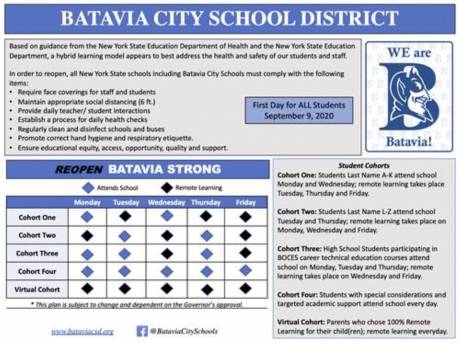
About 315 students in the Batavia City School District will be taught exclusively in a “distance learning” capacity, according to the reopening plan that will be submitted by Friday to the New York State Education Department and Gov. Andrew Cuomo’s office.
Batavia Superintendent Anibal Soler Jr. today shared details of the strategy to educate the district’s nearly 2,200 students as the 2020-21 school year approaches. The first day for all students is Sept. 9.
Prior to submitting its comprehensive report of about 50 to 60 pages, district officials on Monday released a Reopen Batavia Strong graphic that outlines the health protocols that will be in place as well as the daily schedule for students – breaking the Monday through Friday routine into five “cohorts.”
“This is a visual piece for parents – the 30,000-foot view,” Soler said, advising that it can be found on the district website and Facebook page. “The Reopen Batavia Strong Task Force gave us recommendations, input and feedback, and we feel this is a good plan.”
Looking at the graphic, one can see the following:
-- Cohort One: Students with last names beginning with A-K attend school Monday and Wednesday; remote learning takes place Tuesday, Thursday and Friday.
-- Cohort Two: Students with last names beginning with L-Z attend school Tuesday and Thursday; remote learning takes place on Monday, Wednesday and Friday.
-- Cohort Three: High school students taking BOCES career technical education courses (at the building across from Batavia High on State Street) attend school on Monday, Tuesday and Thursday; remote learning takes place on Wednesday and Friday.
-- Cohort Four: Students with special considerations and targeted academic support attend school every day.
-- Virtual Cohort: Parents who chose 100 percent remote learning for their child(ren); remote learning every day.
“It’s important to emphasize that the virtual cohort is parent driven; it is the parents’ choice,” Soler advised, noting that about 15 percent of the student population has opted for distance learning at this time. “We thought it was important to give parents some choice. Some parents feel unsafe, and have the right to feel that way. Some of them don’t want to bring them in until they have full assurance that their health and safety are protected.”
Cohort Four students (around 250) will consist of total in-person learning for students with special needs and considerations, such as disabilities, English language learners and pupils with individualized education plans, Soler said.
“They will have more of an intensive, in-person given the fact that we have some legal obligations with their individualized education plans,” he said. “Also, this cohort will include students that teachers feel need more individual attention as well as access to food and a caring adult every day.”
The superintendent said the thought process was to use last names as a way to keep students from the same household in school together.
“We do know that some families have mixed last names in the household and we will make considerations for those families,” he said.
Soler said district administration and staff are entering uncharted territory.
“We had a rushed experience last year – shutting the schools down fully. Now, we have an idea of the direction we’re heading in,” he said. “This is still all pending the governor’s approval. He could say, this is a good plan, it’s not a good plan. Or he could decide that schools aren’t going to open across the state – they’re going to go virtual. I’m hoping that’s not the case, given the fact we have a low infection rate in this community.”
The governor is expected to announce his decision on reopening between Aug. 1-7.
Until then, maintenance and janitorial staff at the various Batavia schools are reconfiguring desks and disinfecting classrooms.
“The 6-foot social distancing really minimizes how much in-person we can do,” Soler said. “We want to err on the side of safety and health. There are a variety of opinions out there, but we have to go off what we feel is best. We have a responsibility to provide optimal safety and health for any of our families, even if they agree or disagree with wearing masks. We’re bound by the guidance that is put before us.”
Regarding child care, Soler said the “virtual day” was moved from Monday to Friday to have the least negative impact upon families seeking child care.
“We thought it would be easier for them to find someone to watch their kids (on Friday) than on a Monday,” he said.
Teachers will report to school every day and will be able to livestream their classes to include students who are at home, Soler said.
“We believe that’s the least burdensome on our teachers. That way, they won’t have to recreate a lesson. Kids can watch live and interact with their peers in the classroom. It will require us to do some training on best practices on what distance learning looks like,” he explained.
Soler said that a teacher may be assigned to be a full-time virtual educator or may have one of his or her five classes designated as a virtual class. He also said that a schedule is being set up for distance learners, such as having English at 8 a.m., Math at 10 a.m., etc.
Of course, he wishes that all students could be taught in their school buildings.
“We have families that are really adamant about in-person but, again, we just don’t have the capacity,” he said. “We don’t have enough teachers to split every class to maintain health and safety protocols at a high level and we also don’t have enough building space to cut our classrooms in half and basically double each class.”
